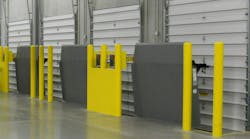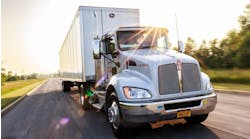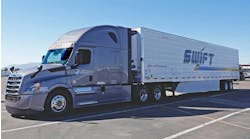Investing In The Future: Advancements In Climate Control
Climate control is critical to quality control in the refrigerated and frozen food sector. However, achieving it is easier said than done. A cold chain can break down at many different points along the route from processor to consumer. Inconsistent temperature during shipment, poor climate control inside the warehouse, or product sitting too long on an open dock or in an open trailer all are common scenarios for temperature-related product damage. Considering the value of a standard OTR food shipment is between $50,000 and $100,000 (with reefer loads going up to $1 million), any weak link in a cold chain’s integrity can become an immensely expensive mistake.
Fortunately, recent advancements have spurred development of a wide range of new equipment to address this issue. These products help ensure proper temperatures from the freezer or cooler through to the loading dock and even onto the semi-trailer or reefer. This article highlights a few of the most significant new offerings.
Climate control inside the trailer
Numerous advancements have been made in refrigerated semi-trailer systems—and not only in the trailers themselves, but also in ancillary equipment. For example, notable upgrades have been made in insulated trailer bulkheads, used to maintain critical temperatures in sections of multi-temp trailers.
The latest models of trailer bulkheads are designed with state-of-the-art materials, strengthening their durability and making them lighter and safer to handle. Thinner, more flexible foam cores and ergonomic handle positioning allow drivers and loaders to place and move the bulkheads with less effort and strain. Other enhanced features include those important for passing FSMA inspections and other food safety audits, such as anti-microbial outer fabric, corrosion-proof handle fasteners, and break-away straps to help reduce damage to foam that can result in harborage of bacteria. Also look for a universal center hinge design that allows easy access to pallets on either side of the bulkhead for optimum loading and unloading efficiency.
Bulkheads come in a variety of configurations, including a two-panel, bi-fold design, as well as a three-panel, Z-shaped configuration that can accommodate odd-number pallets between temperature zones. Single panels also are good to have on hand for quick replacement. Look for a provider that offers bulkhead repair services, as well as new units. Often, trailer bulkheads can be refurbished to provide months or years of life before needing to be replaced.
The advantages of a drive-through loading dock
One of the biggest advancements in cold chain management is in loading dock design, specifically the development of the “drive-through” dock configuration. With a drive-through dock, trucks back up to the loading dock with their doors closed. Once secured at the dock with either wheel chocks or mechanical vehicle restraint, the trailer’s security seal is broken, and the doors are then opened into the building—thus preventing the cargo from being exposed to outside heat and other outdoor elements. This enhances cold chain integrity and cargo security.
Drive-through docks are dependent upon the use of vertical-storing levelers, which are set back far enough from the dock opening to allow trailer doors to swing open inside. They have several other benefits over traditional pit-style levelers. Unlike traditional levelers, a vertical leveler (when in the stored position) allows the loading dock door to close directly on the pit floor, instead of on the leveler. This results in fewer gaps for outside air to get inside a facility’s temperature-controlled operation.
Minimizing outside air infiltration also effectively improves humidity control and reduces energy loss. In addition, the vertical leveler design makes it easy to clean or wash down the pit floor when the leveler is in the upright and stored position, which is another major component to sanitary transport rules in Food Safety Modernization Act (FSMA) standards.
Leading vertical levelers are designed with a constant-radius rear hinge to create a less bumpy transition between the leveler and the warehouse floor, minimizing the jarring vibrations or “dock shock” that forklift drivers often experience when entering or exiting a trailer. They also feature a safety sensor that disables leveler operation when personnel movement is detected in the pit, and if interlocked, disables operation until the pit is cleared and the operator is at the control panel.
Properly sealing the perimeter
Another key to maintaining cold chain integrity is to create a complete environmental seal between the back of the semi-trailer and the inside of the loading dock. This connection is vital in keeping outside air from infiltrating temperature-controlled operations. A complete seal also helps prevent wind, rain, dust, bugs, and other contaminants from entering the building.
Certain dock shelters have been designed with food industry applications in mind, specifically to work with vertical levelers in drive-through applications. Through special design features, such shelters ensure tight sealing against trailer sides, and across the full width of the trailer top and at the corners, without interfering with trailer doors being opened and closed after the trailer has been parked at the dock. An under-leveler seal can help close gaps between the bottom of the trailer and the edge of the loading dock.
The critical role of restraints
Automatic vehicle restraints have become increasingly common at loading docks. With the simple push of a button, they automatically engage a trailer’s rear-impact guard (RIG) or rear wheels to secure the trailer to the loading dock when it backs into position. Restraints help prevent accidents related to premature truck departure, enhance safety for workers at the loading dock, and deter potential tampering that might occur if a trailer isn’t fully secured and able to pull away from the facility.
Industry-leading restraints feature a control panel that can be integrated into building management or security systems, providing another level of security and protection against external tampering. The most advanced restraints re-fire if there is tampering or the trailer attempts to pull away when locked.
High-speed doors trending up
The increased use of high-speed cooler and freezer doors has marked another paradigm shift in cold chain management. While processors traditionally chose heavy doors with high R-values for these applications (since they offer better temperature separation when closed), a growing number now are realizing their slower operating speeds are overly detrimental.
In fast-paced cold operations which require frequent material handling operations, doors with slightly lower R-values that reduce air infiltration with fast cycle times are more practical. And faster doors mean less opportunity for forklift operators to run into the doors. Leading roll-up door models move at up to 100 inches per second, and feature wash-down capabilities and anti-microbial materials, making them ideal for use in the food industry.
In the rare event that a high-speed door is struck, the doors can break from their tracks and re-align when rolled back up. In contrast, traditional rigid doors are much more susceptible to forklift damage, which can lead to improper sealing and becoming ineffective.
Sensors and software
The expansion of sensor technology and smart equipment into shipping operations is another step forward for cold chain safety and efficiency. New dock management software can streamline the conversation between shippers, carriers, and dock management staff by allowing carriers to be assigned docks without the hassle of manual dock checks or the driver ever leaving the cab. They also provide a real-time view of dock utilization across the entire facility.
Other recent advancements include visual dock management tools such as a dock timer. The timer monitors the set shipping window for a dock’s loading activities, including alerting workers when a load is within 30 minutes of its time limit and helping prevent deterioration of perishable product loads and detention/demurrage charges from the carrier.
The smart cold chain
Organizations are looking to smart connected equipment for long-term insights into the safety and efficiency of operations, as well as immediate alerts to problems. Freezer and cooler doors are a good example.
If a smart connected freezer door indicates the door was left opened or did not close properly (causing the product inside to melt or spoil) it will do more than just log that data for future use—it also will send an alert, so the problem can be fixed right away. Similarly, smart connected dock equipment can notify safety managers to a dock door left open without a trailer present, which is both a safety hazard and a potentially harmful break in the cold chain.
Investing in the future
A refrigerated or frozen food cold chain can be broken in many different places before it ever reaches the consumer. To deliver quality food to consumers—and avoid financially catastrophic product spoilage issues—it’s vital that manufacturers and processors employ current best practices in their loading dock operations and equipment. Such choices include using state-of-the art trailer separation bulkheads, drive-through docks fitted with industry-leading dock equipment, dock management software and safety sensors, and topline high-speed cooler and freezer doors.
A facility that invests in its cold chain is protecting its consumers, its employees, its partners, its shareholders—and, in short, its future viability.



